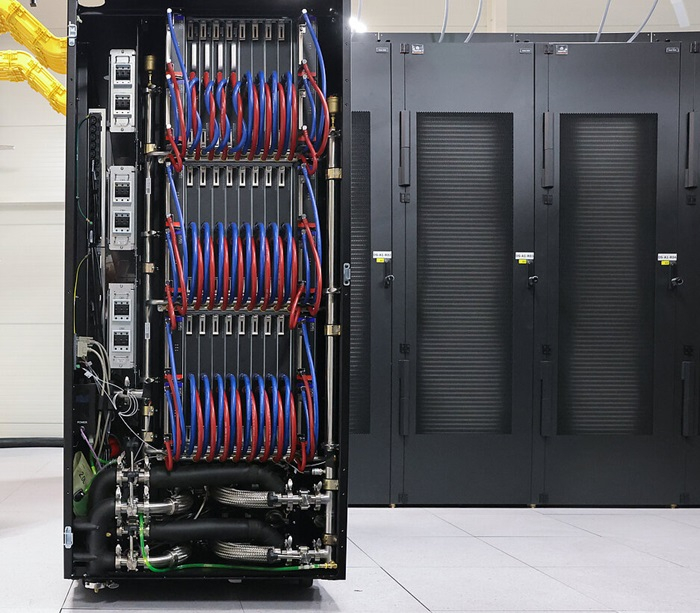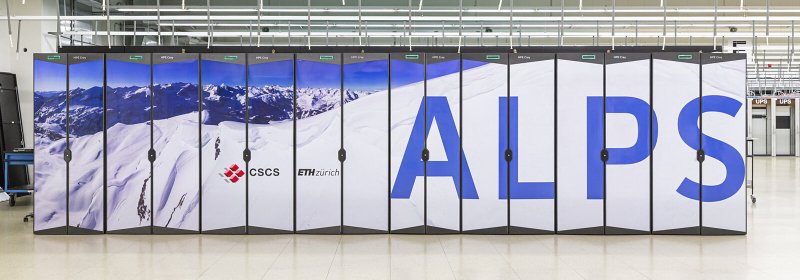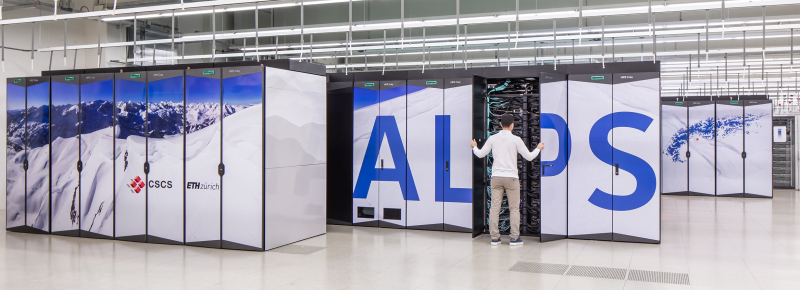ETH Zurich held a ceremony to officially launch the Alps supercomputer at the Swiss National Supercomputing Center (CSCS) in Lugano. The system built by HPE has already taken sixth place in the latest TOP500 ranking and has an established FP64 performance of 270 Pflops (theoretical peak – 354 Pflops). By November, the remaining modules of the machine will be put into operation, and its maximum performance will be about 500 Pflops.

Image source: CSCS
The June TOP500 ranking included a section of 2,688 HPE Cray EX254n nodes with a “fantastic four” NVIDIA Quad GH200. More precisely, this is still the “old” version of the accelerator with H100 (96 GB HBM3), a 72-core Grace Arm processor and 128 GB LPDDR5x – a total of 10752 Grace Hoppers. This section consumes 5.2 MW and is in 14th place in Green500. Nodes, of course, use LSS.
This is the main, but not the only section of the supercomputer. Back in 2020, HPE deployed 1024 dual-processor nodes with 64-core AMD EPYC 7742 (Rome) and 256/512 GB of RAM. Its performance is 4.7 Pflops. In addition, Alps includes 144 nodes with one 64-core AMD EPYC, 128 GB RAM and four NVIDIA A100 (80 or 96 GB HBM2e).

Finally, the machine will receive 24 nodes with one 64-core AMD EPYC, 128 GB RAM and four AMD Instinct MI250X (128 GB HBM2e) and 128 nodes with four AMD Instinct MI300A hybrid accelerators. Most of the nodes will be connected by HPE Slingshot-11 interconnect: 200G connection per node or accelerator. A more precise configuration of the system will be revealed in November.
Luster storage for the future car was updated last year. The main storage system is a Cray ClusterStor E1000 with a Slingshot-11 connection. Thus, 100 PB of usable HDD capacity (8480×16 TB) with a throughput of 1 TB/s (300 thousand IOPS for writing, 1.5 million IOPS for reading) and 5 PB of SSD, as well as reserve capacities, were added. Two tape libraries with a capacity of 130 PB each are responsible for archival storage.

A special feature of the system is its geodistribution (in fact, the nodes are located in four places) and the cloud model of use. Thus, the country’s weather service MeteoSwiss received a dedicated virtual cluster at its disposal, which has already made it possible to switch to the use of a higher resolution weather model that better reflects the complex terrain of Switzerland. In addition, to be on the safe side, some Alps nodes are located on the territory of the École Polytechnique Fédérale de Lausanne (EPFL).
Alps replaces the Piz Daint supercomputer (Cray XC50/40, 21.2 Pflops), the end of its life cycle was announced at the end of July 2024. CSCS will still have the Arolla + Tsa machines (for the needs of MeteoSwiss) and Blue Brain 5 (solves problems of brain reconstruction and simulation). Alps, in addition to traditional HPC workloads, will be used to develop AI solutions.